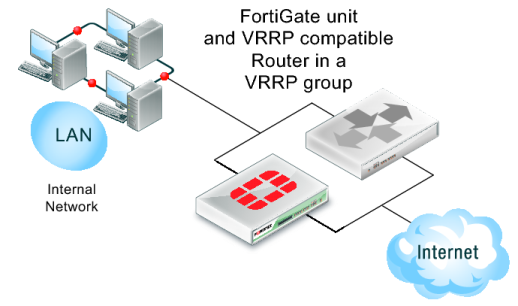VRRP
A Virtual Router Redundancy Protocol (VRRP) configuration can be used as a high availability solution to make sure that a network maintains connectivity with the Internet (or with other networks) even if the default router for the network fails. Using VRRP, if a router or a FortiGate unit fails all traffic to this router transparently fails over to another router or FortiGate unit that takes over the role of the router or FortiGate unit that failed. If the failed router or FortiGate unit is restored, it will once again take over processing traffic for the network. VRRP is described by
RFC 3768.
To configure VRRP you create a VRRP group that contains two or more routers. Some or all of these routers can be FortiGate units. You can include different FortiGate models in the same VRRP group. The group members are configured to be the master router and one or more backup routers of the VRRP group. The network directs all traffic to the master’s IP address and MAC address. If the master fails, VRRP dynamically shifts packet forwarding to a backup router. VRRP provides this redundancy without user intervention or additional configuration to any of the devices on the network.
The VRRP redundancy scheme means that devices on the network keep a single IP address for the default gateway and this IP address maps to a well-known virtual MAC address. If the VRRP master fails, one of the backup units becomes the new master and acquires virtual IP and MAC addresses that match the addresses of the master. The network then automatically directs all traffic to the backup unit. VRRP uses the broadcast capabilities of Ethernet networks. A long as one of the routers in a VRRP group is running, ARP requests for the default gateway IP address always receive replies. Additionally, hosts can send packets outside their subnet without interruption.
FortiGate units support VRRP and can be quickly and easily integrated into a network that has already deployed a group of routers using VRRP. You can also create a new VRRP configuration consisting of a FortiGate unit acting as a VRRP master with one or more VRRP-compatible routers acting as backup routers. Some or all of those backup routers can be FortiGate units.
During normal operation the VRRP master unit sends VRRP advertisement messages to the backup units. A backup unit will not attempt to become a master unit while it is receiving these messages. When a FortiGate unit operating as a VRRP master fails, a backup unit takes its place and continues processing network traffic. The backup unit assumes the master unit has failed if it stops receiving the advertisement messages from the master unit. The backup unit with the highest priority becomes the new master unit after a short delay. During this delay the new master unit sends gratuitous ARPs to the network to map the virtual router IP address it its MAC address. As a result, all packets sent to the default route IP address are sent the new master unit. If the backup unit is a FortiGate unit, the network continues to benefit from FortiOS security features. If the backup unit is a router, after a failure traffic will continue to flow, but FortiOS security features will be unavailable until the FortiGate unit is back on line.
During a VRRP failover, as the backup unit starts to forward traffic it will not have session information for all of the failed over in-progress sessions. If the backup unit is operating as a normal FortiGate unit it will not be able to forward this traffic because of the lack of session information. To resolve this problem, immediately after a failover and for a short time as its taking over traffic processing, the backup unit operates with asymmetric routing enabled. This allows the backup unit to re-create all of the in-progress sessions and add them to the session table. While operating with asymmetric routing enabled, the backup unit cannot apply security functions. When the start-time ends the backup unit disables asymmetric routing and returns to normal operation including applying security functions.


